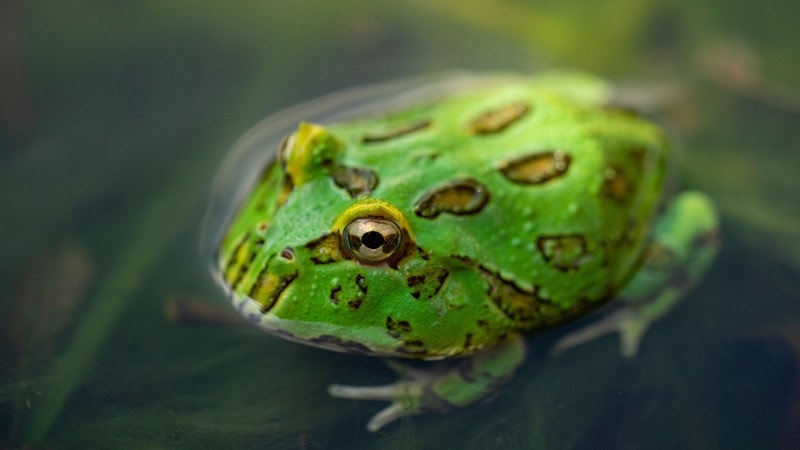What Do Frog Eggs Look Like? Vet-Reviewed Facts & FAQ
By Ed Malaker
Updated on

Click to Skip Ahead
Frogs are great fun to find in the wild, and some amphibian enthusiasts even keep them as pets. They have an interesting life cycle that can be really educational to witness, and for that, you’ll need to know what their eggs look like. Frog eggs are usually small and spherical, found in masses or ‘nests’ of two different types: foam or jelly. Keep reading as we look into each and describe them so you can identify them, and we also explain where frogs hide their eggs.
The Diversity of Frog Eggs
Frog eggs come in various shapes, sizes, and colors, just like the frogs that lay them. The appearance of frog eggs varies between species, reflecting their evolutionary adaptations to their environment. However, they usually fall into two main types, based on their nests: jelly-like and foam-like.

Jelly-Like Frog Nests
Jelly-like frog nests are the most common type. You will find them in ponds, swamps, and other still-water habitats. They have a gelatinous outer coating that protects the developing embryos. These eggs are typically translucent and spherical, with a dark spot in the center. Some species may lay their eggs in clusters under the water or attach them to submerged vegetation for added protection. The vegetation also helps provide food for the tadpoles when they hatch.
Foam-Like Frog Nests
Only a few frog species lay this type, with the foam-like masses of eggs that float on the water’s surface. To get that foamy appearance, the female frog whips the egg mass with her hind legs, causing it to mix with proteins and air. This foam provides insulation and protection for the developing embryos, shielding them from predators and temperature fluctuations.
Size and Color Variation
The size and color of frog eggs vary significantly. Frog eggs are small but can range from 0.04 to 0.16 inches in diameter, depending on the species. As you might expect, small frog species usually lay small eggs, and large eggs are associated with large frog species. Additionally, the coloration of frog eggs varies from clear or white to shades of brown, green, or black. These variations often help camouflage the eggs within their specific habitats, making them less noticeable to predators.
The Development of Frog Eggs
Frog eggs undergo a long and fascinating process from fertilization to hatching. After the female frog lays her eggs, fertilization takes place when the male releases sperm into the water, which penetrates the jelly-like coating of the eggs. The embryos undergo a series of stages within the eggs, beginning as a single cell. Over time, cleavage occurs, where the single cell divides into multiple cells, forming a hollow ball of cells called a blastula. This blastula then develops into a gastrula, where the three germ layers that form the different organs and tissues of the frog begin to take shape. The embryos then develop a spinal cord and a notochord and grow distinct features like eyes and a tail. Eventually, the embryos develop into tadpoles, which hatch from the eggs and begin their independent aquatic life. These tadpoles will undergo further metamorphosis before transforming into fully formed frogs that lay new eggs.

Frequently Asked Questions
Where Can I Find Frog Eggs?
You can usually find frog eggs in aquatic environments, such as ponds, swamps, and wetlands. They will usually be underwater near vegetation or attached to the undersides of leaves.
How Long Does It Take for Frog Eggs to Hatch?
It can take a few days to several weeks for the eggs to hatch and for tadpoles to emerge, depending on the species and environmental conditions.
How Long Does It Take To Go From Tadpole to Frog?
For most frogs, it takes around 14 weeks to develop from tadpole to frog, but some species can take months, even years!

Do All Frog Eggs Look the Same?
No, frog eggs come in many shapes, sizes, and colors. Different frog species have different types of eggs, and even within the same species, there can be variations in egg appearance.
Can I Hatch Frog Eggs at Home?
Most experts do not recommend trying to hatch eggs at home. Frog eggs require specific environmental conditions and care to develop successfully, so it’s best to observe them in their natural habitat or consult experts if you are interested in studying or raising frog eggs.
How Can I Identify the Species of Frog Based on Their Eggs?
Identifying the species of frog based solely on the appearance of their eggs can be challenging. However, certain general characteristics, such as size, shape, color, and habitat, can provide clues that you might be able to compare to a field guide or ask experts who can assist with species identification.
Conclusion
Frog eggs are only a fraction of an inch in diameter, laid in clumps that are either jelly- or foam-like, with the vast majority falling into the former category. They are usually under the water in large clumps, or the frogs can attach them to the undersides of leaves. Although the eggs are often clear with black dots in the center, they can be many colors, and they will go through several stages of development before turning into tadpoles that become frogs.
Featured Image Credit: Daniel Prudek, Shutterstock












